Name George 1st Role Political figure | ||
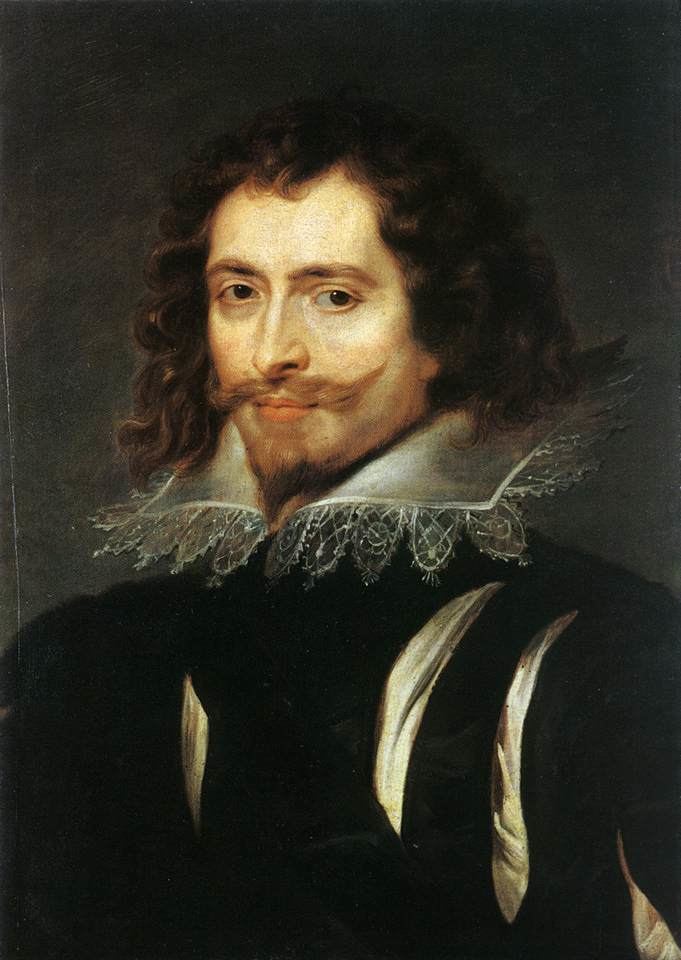 | ||
Spouse Katherine Villiers, Duchess of Buckingham (m. 1620) Children George Villiers, 2nd Duke of Buckingham Parents George Villiers, Mary Villiers, Countess of Buckingham Siblings John Villiers, 1st Viscount Purbeck, Edward Villiers, Christopher Villiers, 1st Earl of Anglesey Similar People Anne of Austria, George Villiers - 2nd Duke, Charles I of England, Cardinal Richelieu, James VI and I | ||
Preceded by The Earl of Worcester | ||
George Villiers, 1st Duke of Buckingham, (; 28 August 1592 – 23 August 1628), was an English courtier, statesman, and patron of the arts. He was a favourite and possibly also a lover of King James I of England. Despite a patchy political and military record, Buckingham remained at the height of royal favour for the first three years of the reign of King Charles I, until a disgruntled army-officer assassinated him.
Contents
- Early life
- Ascent at court
- Relationship with James I
- Influence under James I
- Charles I the Lord Admiral and foreign affairs
- Assassination
- Patronage of the arts
- Descendants
- Legacy
- In popular culture
- References
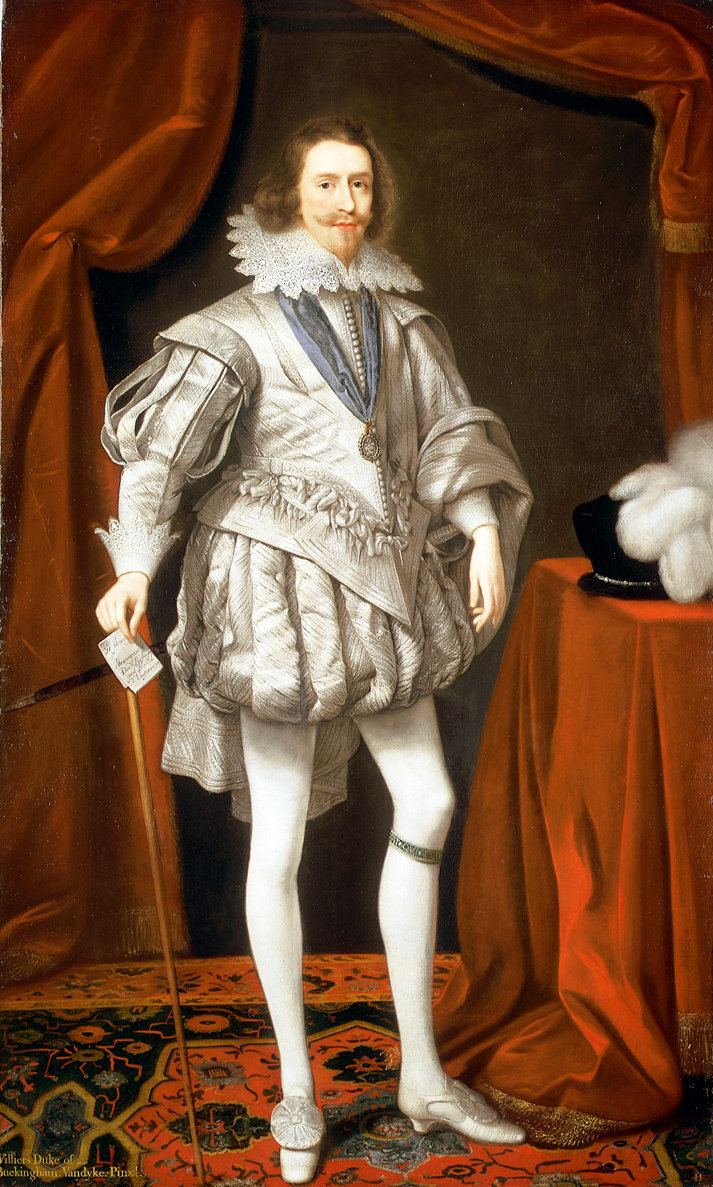
Early life
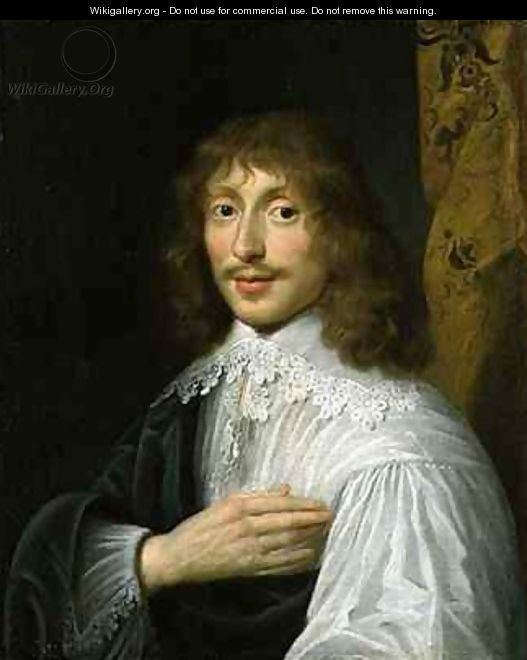
George Villiers was born in Brooksby, Leicestershire, on 28 August 1592, the son of the minor gentleman Sir George Villiers (1550–1606). His mother Mary (1570–1632), daughter of Anthony Beaumont of Glenfield, Leicestershire, was left a widow early and educated him for a courtier's life, sending him to France with Sir John Eliot.
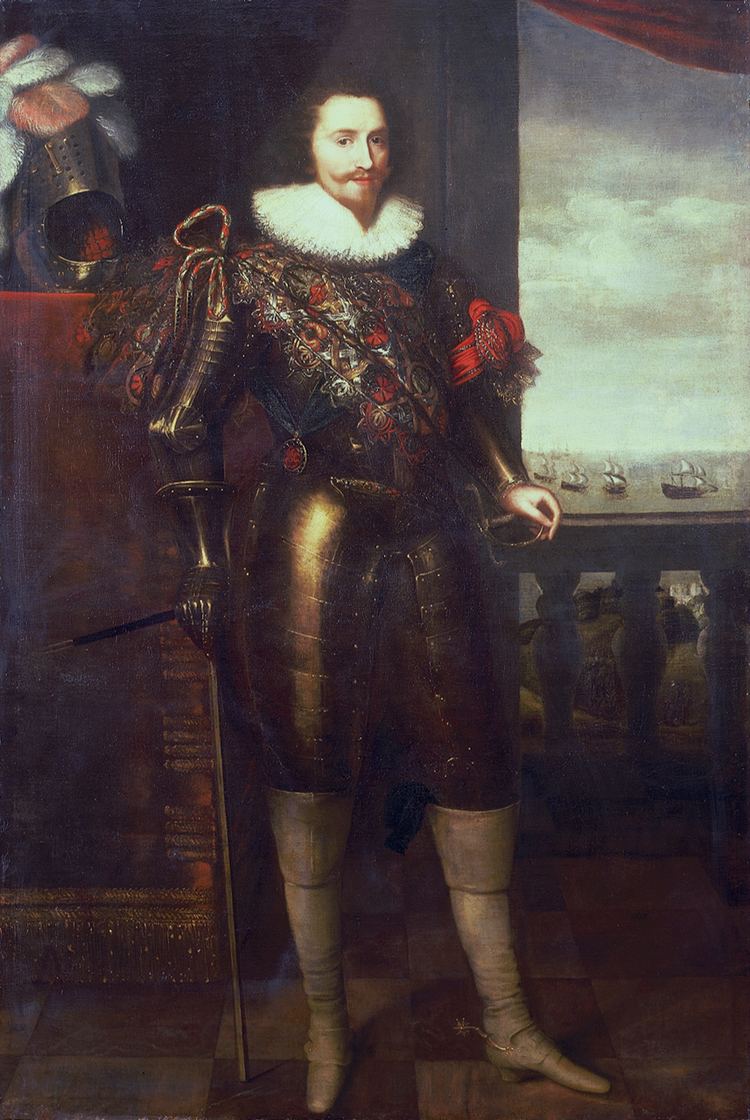
Villiers took very well to the training set by his mother: he could dance and fence well, spoke a little French, and was overall an excellent student. Bishop Godfrey Goodman declared Villiers to be "the handsomest-bodied man in all of England; his limbs so well compacted, and his conversation so pleasing, and of so sweet a disposition".
Ascent at court

In August 1614 at age twenty-one, Villiers caught the eye of James I at a hunt in Apethorpe. Opponents of the king's favourite Robert Carr saw an opportunity to usurp the Earl of Somerset and began promoting Villiers. Money was raised to purchase Villiers a new wardrobe, and intense lobbying secured his appointment as Royal Cupbearer, a position that allowed him to make conversation with the king. Villiers began to appear as a dancer in masques from 1615, in which he could exhibit his grace of movement and beauty of body, a recognised avenue to royal favour since the time of Elizabeth I.
Under the king's patronage Villiers advanced rapidly through the ranks of the nobility, and his court appointments grew in importance. In 1615 he was knighted as a Gentleman of the Bedchamber. In 1616, when he was made the King's Master of Horse, he was elevated to the peerage as Baron Whaddon, Viscount Villiers, and made a Knight of the Garter. The next year he was made Earl and in 1618 promoted Marquess of Buckingham, then finally in 1623 Duke of Buckingham. Villiers' new rank allowed him to dance side by side with the royal heir Charles I, with whom his friendship developed through his tutoring of the prince in dance.
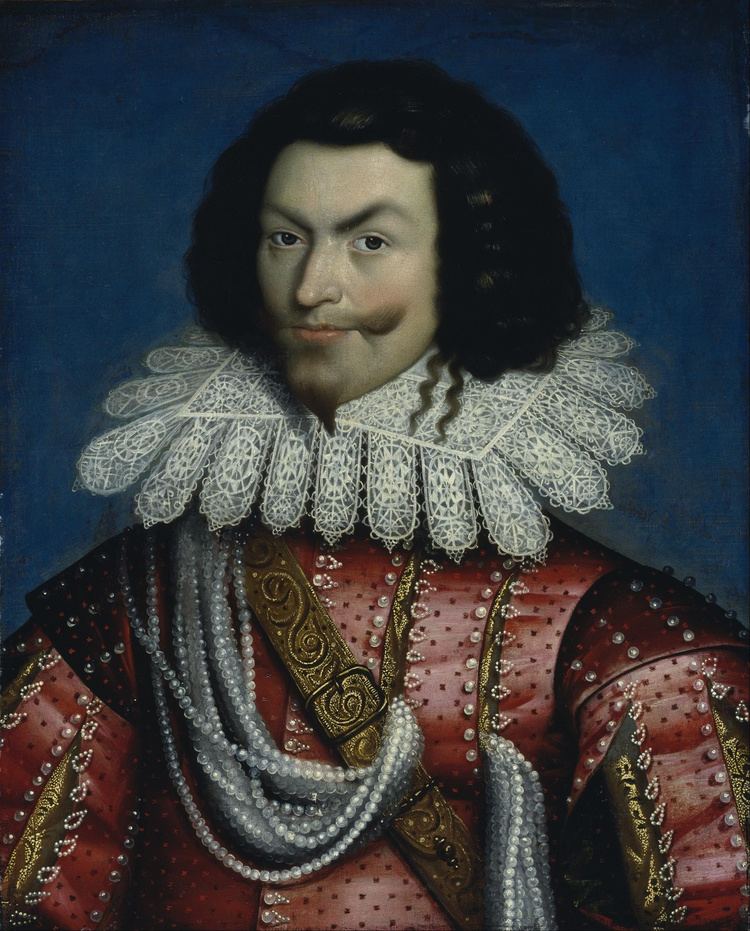
Villiers was appointed Lord Admiral of the Fleet in 1619, and in 1623 the former dukedom of Buckingham was recreated for him when he was negotiating abroad on the king's behalf. Since reductions in the peerage had taken place during the Tudor period, Buckingham was now the highest-ranking subject outside the royal family as the only duke in England.
Relationship with James I
The personal relationships of James are much debated, with Villiers the last in a succession of handsome young favourites the king lavished with affection and patronage. James's nickname for Buckingham was "Steenie", after St. Stephen who was said to have had "the face of an angel". Speaking to the Privy Council in 1617, James tried to clarify the situation in the face of rumours:
You may be sure that I love the Earl of Buckingham more than anyone else, and more than you who are here assembled. I wish to speak in my own behalf and not to have it thought to be a defect, for Jesus Christ did the same, and therefore I cannot be blamed. Christ had John, and I have George.
Historian David M. Bergeron claims "Buckingham became James's last and greatest lover" but his only evidence comes from flowery letters that followed 17th century styles of masculinity. Other scholars say there was no physical sodomy, and note that the king's many enemies never accused him of sodomy..
In a letter to Buckingham in 1623, the King ends with, "God bless you, my sweet child and wife, and grant that ye may ever be a comfort to your dear father and husband". Buckingham reciprocated the King's affections, writing back to James: "I naturally so love your person, and adore all your other parts, which are more than ever one man had", "I desire only to live in the world for your sake" and "I will live and die a lover of you". Restoration of Apethorpe Palace in 2004–8 revealed a previously unknown passage linking his bedchamber with that of James. Buckingham himself provides ambiguous evidence, writing to James many years later that he had pondered: "whether you loved me now…better than at the time which I shall never forget at Farnham, where the bed's head could not be found between the master and his dog".
Influence under James I
Until James I died in 1625, Buckingham was the king's constant companion and closest advisor, enjoying control of all royal patronage. Buckingham used his influence to prodigiously enrich his relatives and advance their social positions, which soured public opinion towards him.
In his rise to power, Buckingham became connected with the philosopher and jurist Francis Bacon. Bacon wrote letters of advice to the young favourite and drafted the patent of nobility when Buckingham ascended to the peerage. With Buckingham's support, Bacon was appointed Lord Chancellor in 1618. In gratitude, Bacon honoured Buckingham's many requests for favours from the court for friends and allies. Following an investigation by Parliament into royal grants of monopoly, financial peculation and corrupt officials, Bacon was convicted of corruption and forced into retirement. Neither Buckingham nor the King attempted to intervene on Bacon's behalf. Many of Buckingham's contemporaries believed he had sacrificed Bacon to save himself from Parliamentary scrutiny, as he had been liberally spending public funds and accepting gifts and bribes.
From 1616, Buckingham also established a dominant influence in Irish affairs, beginning with the appointment of his client, Sir Oliver St John, as Lord Deputy, 1616–22. Thence, he acquired control of the Irish customs farm (1618), dominated Irish patronage at court, particularly with the sale of Irish titles and honours, and (from 1618) began to build substantial Irish estates for himself, his family and clients—with the aid of a plantation lobby, composed of official clients in Dublin. To the same end, he secured the creation of an Irish Court of Wards in 1622. Buckingham's influence thus crucially sustained a forward Irish plantation policy into the 1620s.
When Parliament began its investigation into monopolies and other abuses in England, and later Ireland in 1621, Buckingham made a show of support to avoid action being taken against him. However, the king's decision to send a commission of inquiry to Ireland, that included parliamentary firebrands, threatened to expose Buckingham's growing, often clandestine interests there. Knowing that the king had assured the Spanish ambassador that the Parliament would not be allowed to imperil a Spanish matrimonial alliance, he therefore surreptitiously instigated a conflict between the Parliament and the king over the Spanish Match, which resulted in the Parliament's premature dissolution in December 1621 and a hobbling of the Irish commission in 1622. Irish reforms introduced in 1623–24 by Lionel Cranfield, Earl of Middlesex and Lord Treasurer, were largely nullified by Middlesex's impeachment and disgrace in the violently anti-Spanish 1624 parliament—spurred on by Buckingham and Prince Charles.
Charles I, the Lord Admiral and foreign affairs
In 1623 Buckingham, now Lord Admiral and effective Foreign Minister, accompanied Charles I, then Prince of Wales, to Spain for marriage negotiations regarding the Infanta Maria. The negotiations had long been stuck, but it is believed that Buckingham's crassness was key to the total collapse of agreement, and they returned in a black mood. The Spanish ambassador asked Parliament to have Buckingham executed for his behaviour in Madrid, but Buckingham gained popularity by calling for war with Spain on his return.
He headed further marriage negotiations, but when, in December 1624, the betrothal to Henrietta Maria of France was announced, the choice of a Catholic was widely condemned. Buckingham, whose popularity had suffered a further setback, took a decision to help the rebellious Huguenot Admiral Prince Soubise. An ardent Protestant, Buckingham ordered Sir John Pennington to help; but the Navy only succeeded in attacking Richelieu's enemies, defeating his objects in August 1625 and losing La Rochelle. Similarly he was blamed for the failure of the military expedition under the command of Ernst von Mansfeld, a famous German mercenary general, sent to the continent to recover the Electorate of the Palatinate (1625), which had belonged to Frederick V, Elector Palatine, son-in-law of King James I of England. However, when the Duke of York became King Charles I, Buckingham was the only man to maintain his position from the court of James.
These failures provoked the Commons to refuse further levies of taxation to fund Buckingham's extravagant adventures, while at the same time the duke was accused of being enraptured by intrigues; of dealing a blow to the international Catholic conspiracy. Yet even before they set sail the food was consumed awaiting the Board of Ordnance to deliver the cannonry and musket balls. On this occasion the Lord Admiral was not in command. The experienced admirals were unavailable, so it fell to the newly created Viscount Wimbledon to lead the expedition with one eye on history; to repeat the actions of Sir Francis Drake by seizing the main Spanish port at Cádiz and burning the fleet in its harbour.
Although this plan was tactically sound – landing further up the coast and marching the militia army on the city – the troops were badly-equipped, ill-disciplined and poorly-trained. Coming upon a warehouse filled with wine, they simply got drunk, and the attack was called off. The English army briefly occupied a small port further down the coast before re-boarding its ships. Pennington's curse was a lack of money, but public opinion blamed Buckingham for another disaster. The King too was hurting; England was heading towards war with France.
This was followed by Buckingham leading the Army and the Navy to sea to intercept an anticipated Spanish silver fleet from its American territories. However the Spanish were forewarned by their intelligence and easily avoided the planned ambush. With supplies running out, men sick and dying from starvation and disease, the English limped home in embarrassment.
Buckingham then negotiated with the French Chief Minister, Cardinal Richelieu, for English ships to aid Richelieu in his fight against the French Protestant Huguenots, in return for French aid against the Spanish occupying the Palatinate. Seven English warships participated in operations against La Rochelle and in the Siege of Saint-Martin-de-Ré, but Parliament was disgusted and horrified at the thought of English Protestants fighting French Protestants. The plan only fuelled their fears of crypto-Catholicism at court. Buckingham fought bravely throughout, but Richelieu's ships blocked the narrow channel, and he had to accept defeat by withdrawal. Believing that the failure of his enterprise was the result of treachery, he formulated an alliance among the churchman's many enemies, a policy that included support for the very Huguenots whom he had recently attacked.
In 1627, Buckingham led another expeditionary force. Shortly before departure Buckingham had authorized a new dry dock at Portsmouth to bring Navy Administration up to date; yet it was never built. The Lord Admiral was already bankrupt when he attempted to aid his new Huguenot allies besieged at La Rochelle in France, by leading the renewed Siege of Saint-Martin-de-Ré. He funded the force with Sir William Russell raising £70,000 between them, responsible for the officers out of their own pockets in addition to the victuals. Unpaid for 10 months they looted the King's stores: during the campaign they lost more than 4,000 of a force of 7,000 men. The Admiral Earl of Denbigh was tentative in his attacks on a large French fleet. On 18 September Earl of Lindley arrived with fireships but they did not prove decisive.
Assassination
During the course of his incompetent leadership, Parliament had twice attempted to impeach the Duke. The king had rescued him by dissolving it both times, but public feeling was so inflamed as a result that he was widely blamed as a public enemy. Eventually his physician, Dr Lambe, popularly supposed to assert a diabolic influence over him, was mobbed in the streets and died as a result. Among the pamphlets issued afterwards was one that prophesied
The Duke was stabbed to death, on 23 August 1628, at the Greyhound Pub in Portsmouth, where he had gone to organise yet another campaign. According to an eye-witness account, he lived just long enough to jump up, shouting "Villain!" and making to chase after his assailant, but then fell down dead. The assassin was John Felton, an army officer who had been wounded in the earlier military adventure and believed he had been passed over for promotion by Buckingham.
Such was the Duke's unpopularity by this time that Felton was widely acclaimed as a hero by the public. A large number of poems celebrating Felton and justifying his action were published. Copies of written statements Felton carried in his hat during the assassination were also widely circulated. Many of these described Buckingham as effeminate, cowardly and corrupt, and contrasted him with Felton, who was held up as an example of manliness, courage and virtue. The son of Alexander Gill the Elder was sentenced to a fine of £2000 and the removal of his ears, after being overheard drinking to the health of Felton, and stating that Buckingham had joined King James I in hell. However, these punishments were remitted after his father and Archbishop Laud appealed to King Charles I. Felton was hanged on 29 November and his body was taken to Portsmouth for public display. However, this proved to be a miscalculation by the authorities as it became an object of veneration by the public.
Buckingham was buried in Westminster Abbey. His lavish tomb bears a Latin inscription that may be translated as "The Enigma of the World". Here, too, he was depicted surrounded by mythical figures. The black marble sculptures at each corner include Mars and Neptune, in reference to his military and naval exploits; on the catafalque lie bronze-gilt effigies of the Duke and his wife (who long survived him), cast by Hubert le Sueur. Buckingham is clad in armour, enriched with crossed anchors and with an ermine cloak over it. He wears on his breast the chain and George of the Garter and on his head a ducal coronet, summing up the principal steps in his brief career. He had died at the age of 35.
Patronage of the arts
Throughout his career Villiers commissioned portraits of himself as "a medium for the cultivation of his personal image". These served as a means to underline his advancement at court as well as to aid his political career. In addition, he and his supporters manipulated the production of printed images, sometimes based on these paintings, as propaganda in support of his political aims. Such publications took their strategic place in a widespread war of words in print which spanned from defamatory verses on Buckingham and his poor performance to a translation of a revolutionary Classical epic.
During the Duke's short tenure as Chancellor of the University of Cambridge, he had initiated the purchase of Thomas van Erpe's collection of oriental books and manuscripts on its behalf, although his widow only transferred it to Cambridge University Library after his death. With it came the first book in Chinese to be added to the Library's collections.
Descendants
Buckingham had married the daughter of the 6th Earl of Rutland, Lady Katherine Manners, later suo jure Baroness de Ros, on 16 May 1620, against her father's objections. The children of this marriage were:
- Mary Villiers (bef. 30 March 1622 – November 1685), married firstly Charles Herbert, Lord Herbert, secondly James Stewart, 1st Duke of Richmond and thirdly Colonel Thomas Howard.
- Charles Villiers, Earl of Coventry (17 November 1625 – 16 March 1627), died in infancy.
- George Villiers, 2nd Duke of Buckingham (30 January 1628 – 16 April 1687).
- Lord Francis Villiers (bef. 21 April 1629 – 7 July 1648), died in a skirmish at Kingston during the Second English Civil War.
Legacy
After Buckingham's assassination, a large amount of satirical verse was circulated on the subject. Most of this reflected on how pride goes before a fall and the damage he had done the kingdom, while several pieces commended John Felton's action. The dagger, claimed to have been used by him, was recorded by a late Victorian gazetteer as still on display at the now demolished Newnham Paddox in Warwickshire. This was the seat of the Earls of Denbigh, whose first earl Buckingham's sister Susan had married.
In popular culture
A fictionalised Buckingham is one of the characters in Alexandre Dumas's celebrated 1844 novel Les Trois Mousquetaires (The Three Musketeers), which paints him as in love with Anne of Austria as well as dealing with the siege of La Rochelle and his assassination by Felton. He is described:
At thirty-five, which was then his age, he passed, with just title, for the handsomest gentleman and the most elegant cavalier of France or England. The favourite of two kings, immensely rich, all-powerful in a kingdom which he disordered at his fancy and calmed again at his caprice, George Villiers, Duke of Buckingham, had lived one of those fabulous existences which survive, in the course of centuries, to astonish posterity.
In the 1973 two-film, Anglo-American adaptation of the book — The Three Musketeers and The Four Musketeers — Buckingham (played by Simon Ward) also has a prominent role as an ally of the main characters. The second film includes his assassination by Felton, but (following the original novel in this) depicts the killing as being orchestrated by the fictional Milady de Winter, an agent of the principal villain, Cardinal Richelieu.
Taylor Caldwell's The Arm and the Darkness (1943) also deals with this period in France, while Hilda Lewis' Wife to Great Buckingham (1959) goes so far as to make Buckingham's love for the French queen the main cause of his undoing. The Duke also figures in historical romances like Evelyn Anthony's Charles, The King (1963) and Bertrice Small's Darling Jasmine (2007), although the main focus there is on other protagonists. In Philippa Gregory's Earthly Joys (1998), which has as its subject the famous gardener John Tradescant the elder, the bewitching Duke appears halfway through the novel as the object of Tradescant's love.Gregory Another historical fiction, Ronald Blythe's The Assassin (2004), is written from his killer's point of view as a final confession while awaiting execution in the Tower of London.
Buckingham also appears in the Doctor Who audio drama The Church and the Crown (2002), dealing with the political intrigue of the time. And as George Villiers, he is a major character in Howard Brenton's 2010 play Anne Boleyn as King James I's mate in sexual horseplay.
